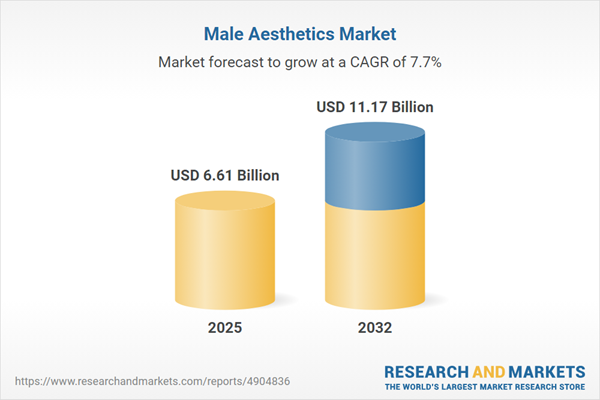Speak directly to the analyst to clarify any post sales queries you may have.
The male aesthetics market is experiencing a phase of robust expansion as evolving cultural expectations and advanced technologies redefine demand, opening new growth avenues for industry stakeholders and setting the stage for increased sector adoption.
Market Snapshot: Male Aesthetics Market Size and Growth Trajectory
The male aesthetics market grew from USD 6.17 billion in 2024 to USD 6.61 billion in 2025 and is on track to maintain a compound annual growth rate of 7.71%, with projections positioning the market to reach USD 11.17 billion by 2032. Industry momentum reflects a shift from niche surgical procedures toward holistic, minimally invasive solutions aligned with consumer expectations for flexibility, personalization, and safety.
Scope & Segmentation: Landscape and Opportunity Areas
This report comprehensively analyzes the male aesthetics sector across segments, regions, and leading technologies, enabling senior decision-makers to navigate the evolving landscape strategically:
- Treatment Type: Minimally invasive procedures (such as fat transfer, laser-assisted lipolysis, liposuction, thread lifts), non-invasive options (body contouring, botox injectables, hair removal, hair restoration, pigment/scar correction, skin resurfacing, skin tightening), surgical interventions (body surgery, facial surgery, hair transplant), and at-home or topical solutions (at-home devices, skincare).
- Technology: Laser technology, radiofrequency, and ultrasound platforms support varied clinical objectives, enhancing precision and patient safety.
- Provider Type: Includes barbershop-adjacent grooming clinics, dermatology practices, franchised clinic chains, and medical spas—each tailored to distinct customer profiles and treatment needs.
- Treatment Frequency: Maintenance/booster sessions, one-time procedures, and series-based interventions support ongoing patient retention strategies.
- Outcome Duration: Options range from temporary (< 6 months) and semi-permanent (6–24 months) to long-lasting and permanent results, catering to a wide spectrum of consumer preferences.
- Geographies: Coverage spans the Americas, Europe, Middle East, Africa, and Asia-Pacific, with sub-regional breakdowns revealing tailored market drivers and adoption patterns.
Prominent Market Participants
- Stryker Corporation
- Zimmer Biomet Holdings, Inc.
- Solta Medical by Bausch Health Companies Inc.
- Abbvie Inc.
- Alma Lasers, Ltd.
- Cartessa Aesthetics
- Cutera, Inc.
- Galderma SA
- Johnson & Johnson Services Inc.
- Merz Aesthetics, Inc.
- Jeisys Medical Inc.
- Leading regional device makers and biotechnology partners.
Key Takeaways for Senior Decision-Makers
- Consumer acceptance of male aesthetics is advancing, propelled by external cultural shifts, targeted digital communication, and improved access to non-surgical modalities.
- Technological innovation, including AI-driven planning tools, energy-based devices, and evolving injectables, expands clinic offerings and enhances patient outcomes with reduced recovery time.
- Providers are repositioning practices as comprehensive wellness hubs, moving beyond single treatments to offer bundled, multi-modality regimens and digital aftercare, increasing patient engagement and retention.
- Strategic supply chain adaptation and local sourcing are proving critical in markets influenced by tariff regimes or regulatory agility, especially where upstream costs or device availability are factors.
- Collaborations between device manufacturers, biotechnology firms, and experienced practitioners are driving portfolio realignment, accelerating go-to-market cycles, and cultivating differentiated clinical competencies.
Tariff Impact: Strategic Adaptations in Supply Chain and Pricing
Recent tariffs imposed in the United States impacted import costs for energy-based devices and consumables. Enterprises responded by optimizing supply chains, strengthening local vendor relationships, and selectively absorbing or passing on costs to maintain market competitiveness. Some industry players leveraged these challenges to innovate domestically and explore consolidation, strengthening sector resilience and long-term sourcing flexibility.
Methodology & Data Sources
This research employs a mixed methodology blending secondary analysis of regulatory filings and clinical studies with expert interviews and quantitative practitioner surveys. Rigorous scenario modeling and triangulation against transactional data underpin a robust, validated perspective for C-level strategic planning.
Why This Report Matters
- Enables decision-makers to identify high-value growth segments and emerging technologies within the male aesthetics market.
- Empowers executives to anticipate regulatory and market shifts, including tariff impacts, with actionable insights for supply chain and partnership optimization.
- Supports informed investment prioritization and competitive benchmarking grounded in validated, region-specific data.
Conclusion
The male aesthetics sector’s evolution presents unique growth levers and operational challenges. Executives leveraging strategic innovation, adaptive sourcing, and data-driven service development are well-positioned to secure leadership positions as the market continues its upward trajectory.
Additional Product Information:
- Purchase of this report includes 1 year online access with quarterly updates.
- This report can be updated on request. Please contact our Customer Experience team using the Ask a Question widget on our website.
Table of Contents
3. Executive Summary
4. Market Overview
7. Cumulative Impact of Artificial Intelligence 2025
Companies Mentioned
The companies profiled in this Male Aesthetics market report include:- Stryker Corporation
- Zimmer Biomet Holdings, Inc.
- Solta Medical by Bausch Health Companies Inc.
- Abbvie Inc.
- Acumed, LLC by Colson Medical, LLC
- Alma Lasers, Ltd.
- Anthony Skin LLC
- Candela Corporation
- Cartessa Aesthetics
- Cutera, Inc.
- Cynosure, LLC
- Galderma SA
- Hanson Medical, Inc.
- Implantech Associates Inc.
- Inmode Ltd
- Institut Straumann AG
- Integra LifeSciences Corporation
- Ipsen Pharma
- Jeisys Medical Inc.
- Johnson & Johnson Services Inc.
- KLS Martin Group
- Lattice Medical SAS
- Medytox, Inc.
- Merz Aesthetics, Inc.
- Nobel Biocare Services AG
- Quanta System S.p.A.
Table Information
| Report Attribute | Details |
|---|---|
| No. of Pages | 191 |
| Published | October 2025 |
| Forecast Period | 2025 - 2032 |
| Estimated Market Value ( USD | $ 6.61 Billion |
| Forecasted Market Value ( USD | $ 11.17 Billion |
| Compound Annual Growth Rate | 7.7% |
| Regions Covered | Global |
| No. of Companies Mentioned | 27 |









